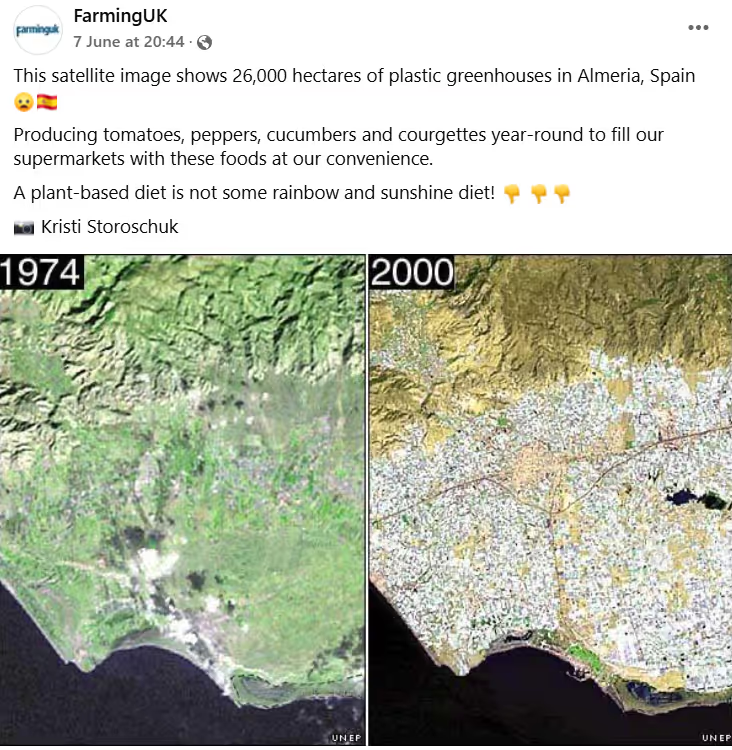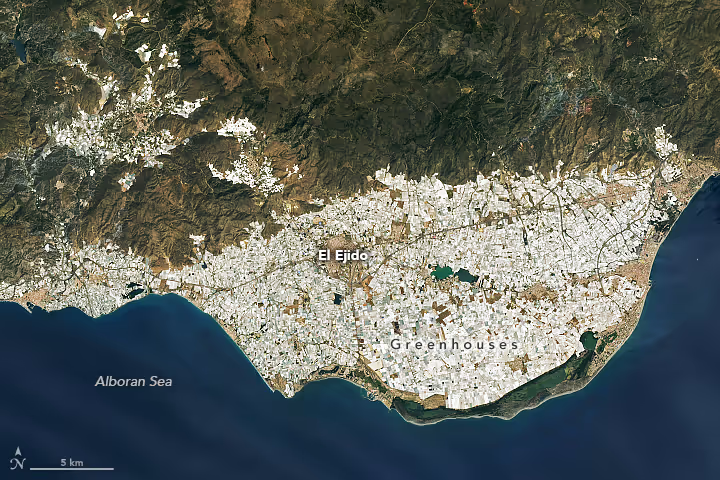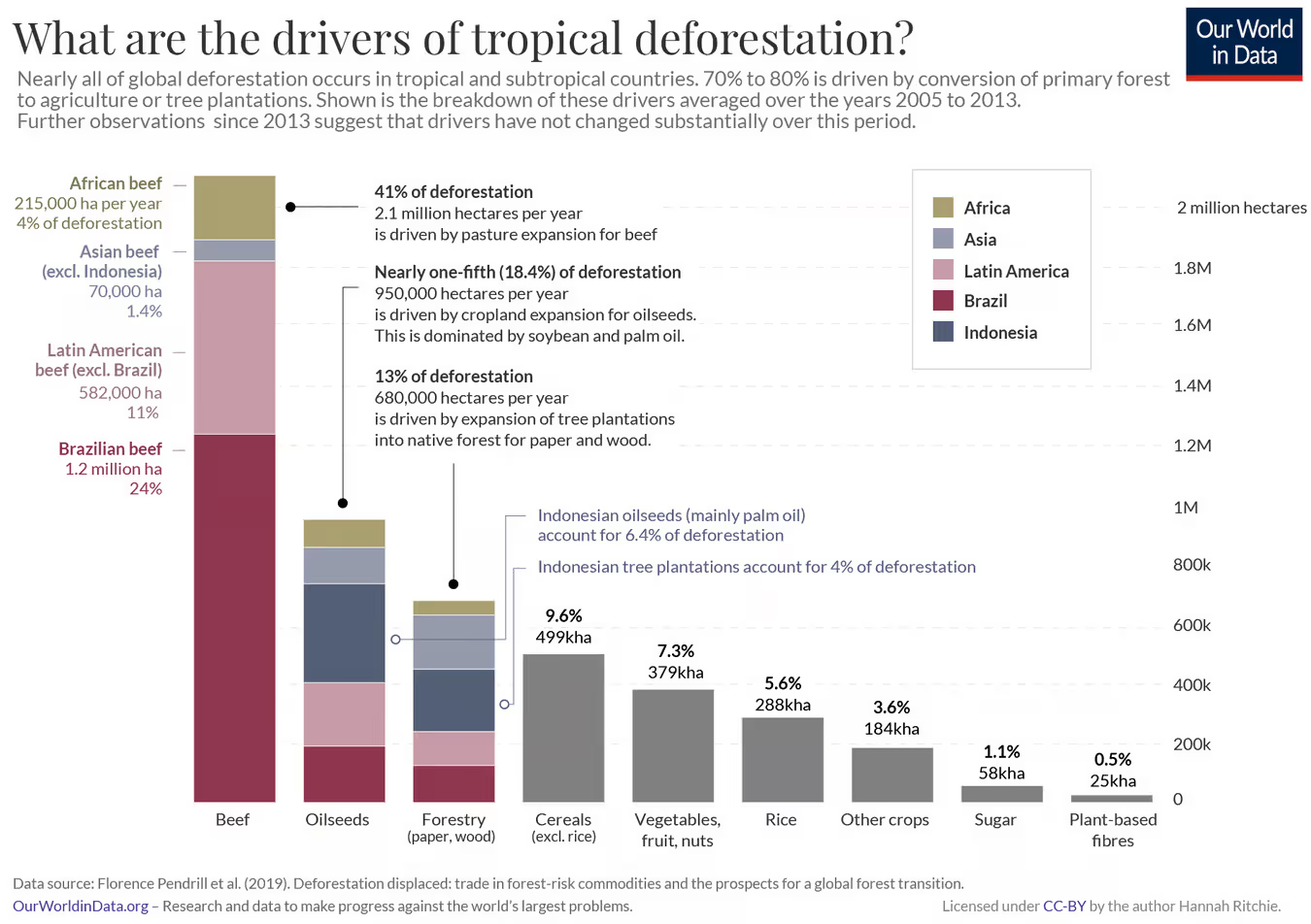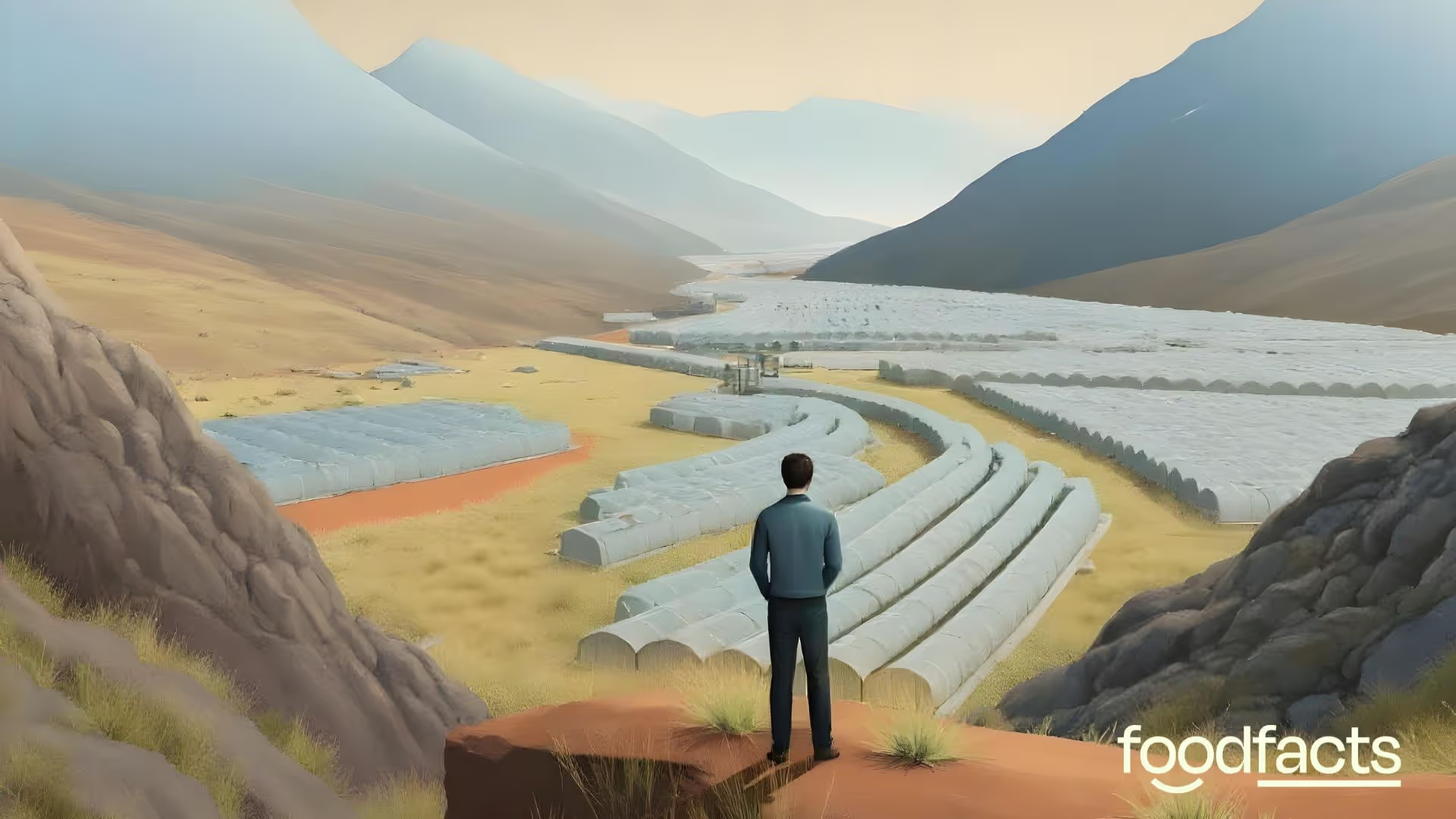
Are plastic greenhouses in Spain caused by plant-based diets?





Coral Red: Mostly False
Orange: Misleading
Yellow: Mostly True
Green: True
Learn more about our fact-checking policies
Posted by FarmingUK on Facebook (7 June), an image shows two satellite images (from 1974 and 2000) illustrating rapid expansion of plastic-covered greenhouses in Almería, Spain. It suggests that this expansion is directly linked to the growing demand for plant-based diets and implies negative environmental impacts of such diets.
Claim:
“This satellite image shows 26,000 hectares of plastic greenhouses in Almería, Spain... Producing tomatoes, peppers, cucumbers and courgettes year-round… A plant-based diet is not some rainbow and sunshine diet!”

Greenhouse agriculture in Almería serves a global market that includes both plant-based and omnivorous eaters. While the region raises valid concerns about plastic waste, labor conditions, and water usage, attributing it primarily to veganism distorts the broader agricultural reality.
With rising awareness around sustainability, these kinds of claims can unfairly undermine plant-based diets using out-of-context visuals. This can create confusion and backlash, especially when backed by agricultural lobbies with vested interests.

🥔 Dig Deeper: Images can be powerful, but they don’t always tell the full story—especially when used without context.
Fact-Check Part 1: Is the Image Accurate?
Yes, the satellite imagery is authentic. The NASA Earth Observatory has published similar comparative visuals documenting the transformation of the Campo de Dalías in Almería into one of Europe’s largest greenhouse hubs. By 2022, over 40,000 hectares were covered in plastic greenhouses.

Satellite images confirm the rapid expansion of intensive horticulture in southern Spain, especially since the 1960s. The vegetables grown here are exported across Europe, contributing to the year-round availability of fresh produce in supermarkets.
Fact-Check Part 2: Who Is Driving the Demand?
The crops grown in Almería—tomatoes, peppers, cucumbers, courgettes—are staples in omnivorous, vegetarian, and vegan diets alike. While demand for plant-based products has increased, these vegetables have always been widely consumed, regardless of dietary preference. Research shows that the largest driver of land conversion and deforestation globally is livestock, or more specifically, growing food for farmed animals to eat.

According to research from Ritchie & Roser (Our World in Data, 2020), only a small proportion of greenhouse-grown produce can be tied specifically to vegan diets. The largest share is linked to general food consumption patterns, especially in high-income countries seeking out-of-season fresh produce.
Fact-Check Part 3: Is a Plant-Based Diet to Blame?
The post’s framing suggests plant-based diets are environmentally harmful because of plastic pollution from greenhouses. However, a comprehensive review by Poore and Nemecek (2018) in Science found that plant-based diets still have a far smaller environmental footprint—including lower greenhouse gas emissions, water use, and land use—compared to diets high in meat and dairy.
A 2023 meta-analysis in Nature Food reinforced these findings, showing that vegan diets contribute 75% less greenhouse gas emissions than diets high in animal products. The net ecological benefit of plant-based diets remains positive, even when accounting for intensive crop systems.
Conclusion & Score
Final Verdict: 🟠 Misleading
While the image is real and plastic agriculture in Almería is a serious environmental concern, attributing this problem primarily to plant-based diets is oversimplified and misleading. The greenhouse agriculture sector supports global food demand across all diets, not just veganism.
📚 Resources
- European Environment Agency (2017). Climate change, impacts and vulnerability in Europe. https://www.eea.europa.eu/publications/climate-change-impacts-and-vulnerability-2016
- NASA Earth Observatory (2022). Almería’s Sea of Greenhouses. https://earthobservatory.nasa.gov/images/150070/almerias-sea-of-greenhouses
- Poore, J., & Nemecek, T. (2018). Reducing food’s environmental impacts through producers and consumers. Science. https://doi.org/10.1126/science.aaq0216
- Ritchie, H., & Roser, M. (2020). Environmental impacts of food production. Our World in Data. https://ourworldindata.org/environmental-impacts-of-food
- Ritchie, H (2021). Drivers of Deforestation. https://ourworldindata.org/drivers-of-deforestation
- Springmann, M. et al. (2023). The health and environmental impacts of diets globally. Nature Food. https://doi.org/10.1038/s43016-023-00766-7
- WWF. Deforestation and Forest Degradation. https://www.worldwildlife.org/threats/deforestation-and-forest-degradation



Foodfacts.org is an independent non-profit fact-checking platform dedicated to exposing misinformation in the food industry. We provide transparent, science-based insights on nutrition, health, and environmental impacts, empowering consumers to make informed choices for a healthier society and planet.
🛡️ Stand Against Nutrition Misinformation
Misinformation is a growing threat to our health and planet. At FoodFacts.org, we're dedicated to exposing the truth behind misleading food narratives. But we can't do it without your support.
Your monthly donation can:
✅ Combat viral diet myths and corporate spin
✅ Support our team of dedicated fact-checkers and educators
✅ Keep our myth-busting platforms running

Was this article helpful?
















.svg)
